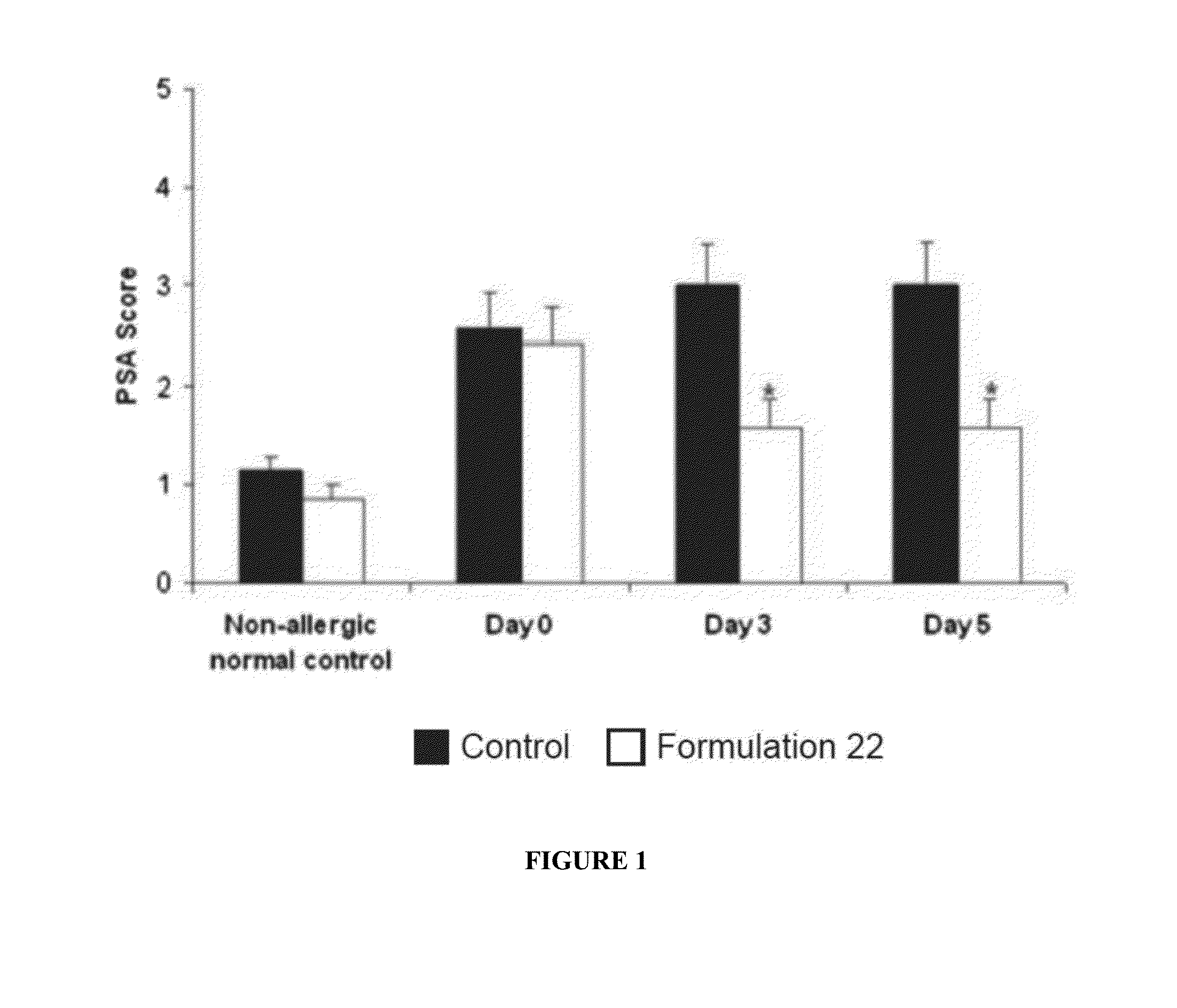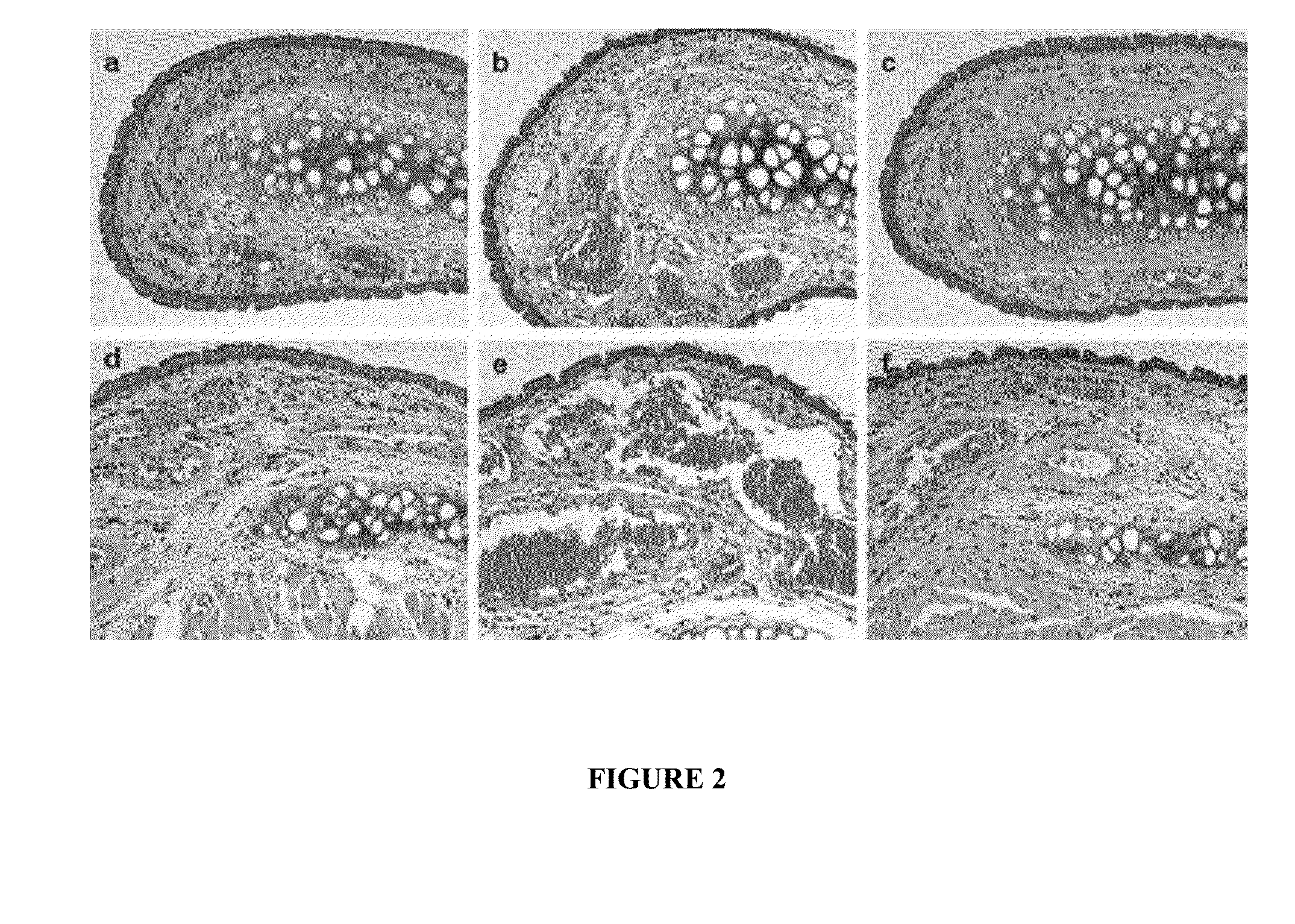Compositions and Methods for Safe Treatment of Rhinitis
a technology for rhinitis and compositions, applied in the field of compositions and methods for treating rhinitis, can solve the problems of long-term desensitization process with limited effectiveness for many patients, significant impairing the quality of life of patients, and raising certain procedural issues as well as safety concerns, so as to minimize the possibility of drainage or leakage
- Summary
- Abstract
- Description
- Claims
- Application Information
AI Technical Summary
Benefits of technology
Problems solved by technology
Method used
Image
Examples
example 1
Topical Formulations
[0042]Table 1 shows 35 exemplary lyophilized topical botulinum toxin formulations that were prepared in accordance with the present invention. Each formulation was prepared by adding the respective components in the indicated amounts to a standard 2 ml lyophilization vial. The column heading “Toxin (ng / vial)” refers to the amount of botulinum toxin type A neurotoxin present (in nanograms per vial), while the column heading “peptide (mg / ml)” refers to the amount of the peptide RKKRRQRRR-Q-(K)15-Q-RKKRRQRRR (SEQ ID NO:18) present (in milligrams per vial). Table 1-1 shows the same 35 exemplary lyophilized topical botulinum toxin formulations as in Table 1, except that the numerical entries in Table 1-1 refer to the respective weight percent of the components relative to the total weight of the lyophilized formulation.
TABLE 1Exemplary topical botulinum toxin formulationsSodiumCitrateHistidinieToxinPeptidedehydrateHistidineHydrochlorideTrehaloseMethioninePoloxamer 188...
example 2
Topical formulations
[0043]Table 2 shows twelve exemplary lyophilized formulations that were prepared according to the invention. Each formulation was prepared by adding the respective components in the indicated amounts to a standard 2 ml lyophilization vial. The column heading “Toxin (ng / vial)” refers to the amount of botulinum toxin type A neurotoxin present (in nanograms per vial), while the column heading “peptide (mg / ml)” refers to the amount of the peptide RKKRRQRRR-Q-(K)15-Q-RKKRRQRRR (SEQ ID NO:18) present (in milligrams per vial). Table 2-1 shows the same twelve exemplary lyophilized topical botulinum toxin formulations as in Table 2, except that the numerical entries in Table 2-1 refer to the respective weight percent of the components relative to the total weight of the lyophilized formulation.
TABLE 2Exemplary Botulinum Toxin FormulationsHistidineBoricPropylFormu-ToxinPeptideHistidinehydrochlorideSucroseTrehaloseSorbitolGlycerolAcidGallatePolysorbate 20lation(ng / vial)(mg / ...
example 3
Reconstitution of Formulations
[0044]The lyophilized formulations listed in Tables 1 and 2 generally are used after reconstitution with a diluent. Generally, any pharmaceutically acceptable diluent that does not undergo undesirable reactions with the components contained in the respective formulation may be used. For example, the formulations listed in Tables 1 and 2 may be reconstituted using water, saline, or phosphate buffered saline. Optionally, one or more additives may be included in the diluent to control or improve certain properties of the diluent, non-limiting examples of which include viscosity enhancers (e.g., a poloxamer, such as poloxamer 188 or 407), anti-oxidants (e.g., BHT or methionine), co-solvents (e.g., an alcohol, such as ethanol) , and / or tonicity adjusters (e.g., a salt, such as sodium chloride).
[0045]For the formulations listed in Tables 1 and 2, it is convenient to reconstitute using 1 ml of diluent, since the formulations are stored in 2 ml vials. Thus, the...
PUM
| Property | Measurement | Unit |
|---|---|---|
| pH | aaaaa | aaaaa |
| concentration | aaaaa | aaaaa |
| concentration | aaaaa | aaaaa |
Abstract
Description
Claims
Application Information
 Login to View More
Login to View More - R&D
- Intellectual Property
- Life Sciences
- Materials
- Tech Scout
- Unparalleled Data Quality
- Higher Quality Content
- 60% Fewer Hallucinations
Browse by: Latest US Patents, China's latest patents, Technical Efficacy Thesaurus, Application Domain, Technology Topic, Popular Technical Reports.
© 2025 PatSnap. All rights reserved.Legal|Privacy policy|Modern Slavery Act Transparency Statement|Sitemap|About US| Contact US: help@patsnap.com



